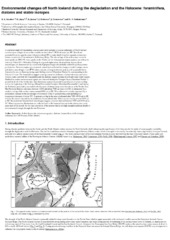| dc.description.abstract | A combined study of foraminifera, diatoms and stable isotopes in marine sediments off North Iceland records major changes in sea surface conditions since about 15800 cal years (yr) BP. Results are presented from two gravity cores obtained at about 400 m water depth from two separate sedimentary basins on each side of the submarine Kolbeinsey Ridge. The chronology of the sedimentary record is based partly on AMS 14C dates, partly on the Vedde and the Saksunarvatn tephra markers, as well as the historical Hekla AD 1104 tephra. During the regional deglaciation, the planktonic foraminiferal assemblages are characterised by consistently high percentages of sinistrally coiled Neogloboquadrina pachyderma. However, major environmental variability is reflected by changes in stable isotope values and diatom assemblages. Low ∂18O values indicate a strong freshwater peak as well as possible brine formation by sea-ice freezing during a pre-Bølling interval (Greenland Stadial 2), corresponding to the Heinrich 1 event. The foraminifera suggest a strong concurrent influence of relatively warm and saline Atlantic water, and both the foraminifera and the diatoms suggest mixing of cold and warm water masses. Similar but weaker environmental signals are observed during the Younger Dryas (Greenland Stadial 1) around the level of the Vedde Ash. Each freshwater peak is succeeded by an interval of severe cooling both at the beginning of the Bølling–Allerød Interstadial Complex (Greenland Interstadial 1) and during the Preboreal, presumably associated with the onset of intense deep water formatiom in the Nordic Seas. The Holocene thermal optimum, between 10200 and about 7000 cal years (yr) BP, is interrupted by a marked cooling of the surface waters around 8200 cal yr BP. This cold event is clearly expressed by a pronounced increase in the percentages of sinistrally coiled N. pachyderma, corresponding to a temperature decrease of about 3°C. A general cooling in the area is indicated after 7000–6000 cal yr BP, both by the diatom data and by the planktonic foraminiferal data. After a severe cooling around 6000 cal yr BP, the planktonic foraminiferal assemblages suggest a warmer interval between 5500 and 4500 cal yr BP. Minor temperature fluctuations are reflected both in the foraminiferal and in the diatom data in the upper part of the record, but the time resolution of the present data is not high enough to pick up details in environmental changes through the late Holocene. | en_US |
